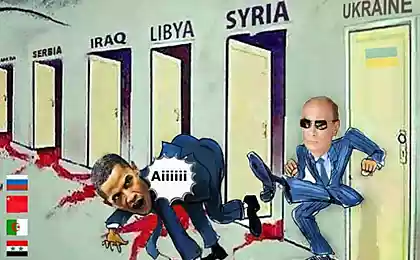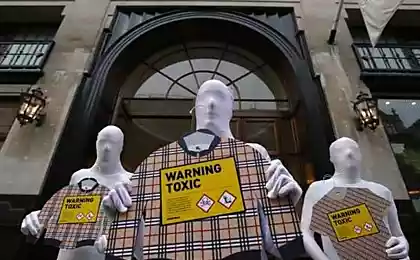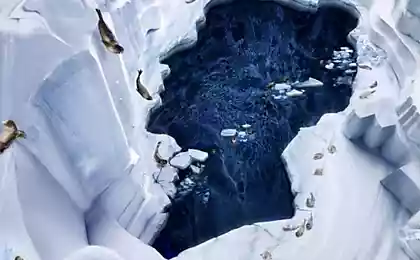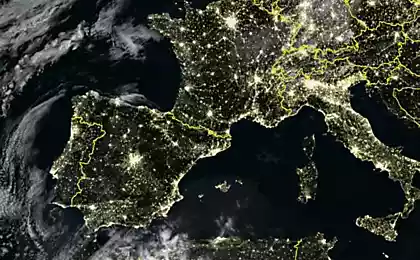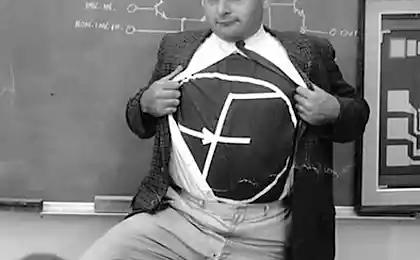246
Seti "Grinpis"
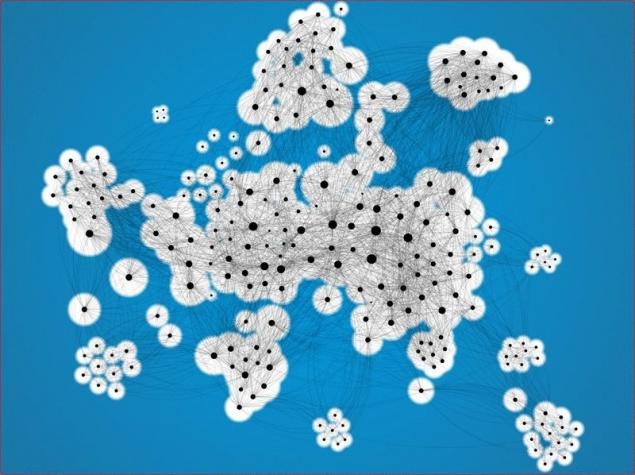
“The secret to the success of this organization lies in the secret of the success of its founder: no matter what is true, what matters is what people regard as true. You're the one you've been exposed to in the press. The organization has become a myth and at the same time a machine for creating this myth.
“Machiavellianism and mysticism played equal roles in shaping the worldview of the organization. At times this has come to religious zeal, and at other times to cruelty bordering on barbarism. Salvage and greatness went hand in hand, reaping their fruits. ?
These two phrases were not about the North Atlantic alliance. Not about the Italian “cosa nostra” or one of the terrorist “brigades”. Not about a totalitarian sect sucking faith and money out of millions of fanatics. It's not about the information empire that's swept the Earth. And even the notorious Masonic lodges have a very remote relation to these statements. It was about Greenpeace, the most powerful and most famous international environmental organization in the world today. The first belongs to its co-founder, Paul Watson, who eventually founded the rival environmental society Sea Shepherd. The second quote is an excerpt from the book Rainbow Warriors by fellow Greenpeace co-founder and spiritual father Robert Hunter.
Its main creator, about whom Watson spoke so unflatteringly, was David McTaggart, in “past life” – an unsuccessful real estate agent who managed to escape from his company a moment before its investors and his own relatives went bankrupt. Unfortunately, not a word is said about this in the tearful official biography of the founder of Greenpeace - an indispensable attribute of any "gurus" claiming to be messianic. In 1971, the 39-year-old McTaggart suddenly saw the light and decided to save the planet.
It was then, twenty-eight years ago, that an environmental organization under the romantic name Green World was founded by a group of enthusiasts, which eventually grew into a transnational corporation with offices in 27 countries and five million members around the world. You can guess the time when Greenpeace settled in Russia, elementary: 1992. McTaggart is most remembered for what squabbles and mud streams he broke out in 1979 to the top of the management of Greenpeace, when not for life, but for death in the battle for his new head seized branches of this organization around the world. On the eve of the collapse of the USSR, McTaggart resigned as head of Greenpeace, becoming its honorary chairman and promising to continue to deal mainly with "helping the Soviet Union to clean up its environment." The “young wolves” who replaced him zealously took up the continuation of the “guru” business, and today Greenpeace has become the flagship of the “green” movement.
Today, Greenpeace is a declaratively cosmopolitan organization, formally not subordinate to any political or economic force in the world and completely financially uncontrolled by anyone. In these qualities with “Greenpeace” can be compared only a few religious denominations and, perhaps, still existing secret societies, their networks interweave the world. Greenpeace has long been a thriving economic monster, spending just over a third of its total on environmental campaigns: in 1998, that figure was only 38 percent of total spending. The rest is spent mainly on investing in various funds (21%), “the needs of the administration” (15%), on vague “support of shares” (9%), informing the public about their merits (9%) and spending on positive reviews in the press (8%). Greenpeace’s net profit for 1998 was almost $101 million. According to Greenpeace’s official statistics, out of 125 million in total income, 121 million come from private donations of 2,400,000 “invisible ordinary citizens” around the world.
In addition to the fact that such a financing scheme is extremely unstable and more suitable for one-time actions of “relatively honest money withdrawal”, this “form of work with depositors” is an excellent reason for lobbying, if not elementary buying up Greenpeace programs on the root by public authorities of interested countries or individuals. The parable became a deafening scandal of the late 70s, when French journalists proved that the protests of the local branch of Greenpeace against the construction of nuclear power plants in France were paid for from the American pocket, and the actions of the Protestants were coordinated with the US government, which promoted its energy companies to the European market. Since then, the French have become completely allergic to all green stocks and movements in general.
Greenpeace is a strictly hierarchical organization, modeled after military formations, with paramilitary units and support units, uniforms, autonomous means of communication. The degree of preparation for a particular action at Greenpeace corresponds to the planning of the army operation. Greenpeace has hundreds of scientific laboratories, computer centers, analytical departments and marketing teams coordinated from a single center of the organization, the so-called Stichting Greenpeace Council. Everything is calculated: from organized pressure on “sympathizers” in the government, parliament, business circles of the chosen country and the necessary coverage of the action in the local and world press to the development of the symbolism of the action and the selection of photogenic performers. Not a single action, not even the most overwhelming one in Tynda or New Caledonia, can pass without the approval of the board of Greenpeace International. Such an organization allows you to solve the tasks with a high degree of efficiency. At the same time, in its statutory documents, Greenpeace advocates for necessarily active, but formally “non-violent” methods of conducting its actions. However, it is clear that in the case of blocking nuclear reactors or elementary robbery attacks on ocean fishing vessels, it is not necessary to talk about the pacifist harmlessness of the Greens.
Greenpeace is an organization that has created and professed its own moral principles, which are categorically attributed to “every normal person on the planet.” It has assumed the right to control every corner of the world and in one way or another punish the “disobedient.”
Greenpeace’s favorite technique for spreading “green” morality is to show oppressive, pressing on the brains of three-minute videos with a typical video sequence: smoke from the factory pipe – killing seals with sticks – rotting whale skeleton – colorful yacht Greenpeace – duck in oil – deforestation. How such clips are made is known. A shameful case of the early 80s: Danish journalist Leif Blodel proved that during the shooting of another video, Greenpeace deliberately paid Australian kangaroo hunters for torturing and killing animals in front of the cameras. Everyone knows that the “green” fall into ecstasy at the sight of deforestation. They fought against this for a long time - until a wild scandal! - in an original way: they stuck small peaks into the trees so that they would plunge into the bodies of workers. This is what the co-founder of the eco-organization “Earth – First” Michael Rosell, who subsequently warmed up Greenpeace, became famous for.
Often a conduit of intelligence interests, Greenpeace dictates its terms to sovereign governments, waging an undeclared war with thousands of firms, businesses and companies around the world. As a result, Greenpeace appears to be an excellent cover for intelligence and sabotage activities, to suppress impregnable competitors, to interfere in the internal affairs of sovereign states.
Greenpeace is not interested in pesticides in Russian fields. To put it mildly, its selectivity was most clearly manifested during the recent bombing of Serbia with shells with uranium fillers and graphite bombs, and even earlier - during a real environmental disaster, which led to the American bombing of Iraqi oil facilities. In both of these cases, Greenpeace did not hit a finger to influence the US and Europe. But you can’t drag them away from Russian nuclear facilities, chemical plants, machine-building plants and mines. Numerous handbooks, statistics, measurements are a convenient way to collect data on secret enterprises under the guise of peaceful environmentalists with impunity. But the special attention of Greenpeace activists has always been paid to people: the military, specialists, journalists, all those who can have access to state secrets. By the way, recently the trial of a military journalist was completed – he was not imprisoned for espionage because they could not prove the malicious intent of his transfer to foreign media of secret data about our military facilities under the guise of environmental measurements. Of course, he was actively defended by both the latter and Greenpeace. Without delving further into this order of intricate matter, let us give a characteristic example of such protection. The journalist was accused, among other things, of transferring the scheme of the Russian coastal base. So, “ecologists” justified the journalist as follows: they say, “in 1995 in the open report “Greenpeace” was the most detailed and meticulous way described this base.” In other words, the journalist did not in any way conduct espionage activities against Russia, because much earlier Greenpeace shot all the cream!
What specific goals does Greenpeace declare? and how does it achieve them? Greenpeace itself puts forward four areas of its work. It is a “biodiversity campaign – the fight against deforestation, barbaric fishing and whale hunting, for the conservation and creation of new protected natural areas.” It is a campaign to protect the atmosphere – to reduce greenhouse gas emissions and eliminate the use of ozone-depleting substances. This is a campaign on toxic substances for the prohibition of dangerous technologies and pollution of the environment with highly toxic substances. This is an anti-nuclear campaign for the reduction of nuclear arsenals, the prohibition of nuclear tests, the gradual abandonment of nuclear energy.
Already, these officially declared goals raise questions. How, for example, is a non-governmental and “independent” ecological society going to contribute to the “reduction of nuclear arsenals”, the problem of which has long gone beyond the scope of discussion “at the public level”, becoming the property of military analytical institutions and the subject of state will?
However, the declared goals can still be accepted as very noble thoughts, advocating the preservation of the planet in its original purity. (Let us leave this delicate point out here: it is always easier to take care of the good of the environment for “promoted” companies with huge capitals, most of which were earned 20-30 years ago precisely by merciless destruction of nature.) Of course, among them are always the most notorious “fighters for the beauty of the Earth”.
Let’s go back to the “principal areas.” How does Greenpeace fight for biodiversity? Elementary: through pressure on state circles and local public opinion ruins the “sinful” companies and puts all their workers on the street, offering nothing in return. It happens to everyone, be it Norwegian whalers or Canadian lumberjacks. The destruction of entire villages of Norwegian whalers, in which whole family dynasties from time immemorial were engaged in a brave business, fishing for whales, is known to the whole world. Greenpeace has little interest in the fact that whalers from year to year – until the ban – have followed the Norwegian official quota, which does not exceed 0.04% of the total number of whales in the Atlantic and Southern Hemisphere!
Greenpeace does not disdain the war against individuals. A blatant case that went around the world press: at the insistence of “ecologists” in 1986, Professor Richard Lambertsen was fired from the University of Florida – “for research requiring fragments of whale organ tissue,” which, according to experts from Greenpeace, were “scientifically unjustified.” The fact that the professor’s research was aimed at identifying whale diseases could not stop the show: so colorful were the slogans flying over the filled football stadiums: “University of Florida!” Stop killing whales! Such “methods”, of course, are used by Greenpeace not only in America and not only against biological scientists. Special attention should be paid to the whole combinations that Greenpeace played to achieve its goal.
One of these classic schemes was described in the magazine Forbes. The point is this. There is a universally recognized International Whaling Commission, founded in 1946 by countries that are engaged in whaling, mainly Japan, Iceland, the USSR and Norway. Its purpose was to regulate hunting in order to avoid irreparable consequences. The participating countries paid about $25,000 annually and held regular assemblies. Everything was going well until Greenpeace got involved. Taking advantage of the fact that any state could become a member of the commission, they secured membership of dwarf states such as Antigua, Panama and Saint Lucia. And since no one saw whales born in these countries, representatives of these states in the commission were “prominent international specialists”. Needless to say, that suddenly turned out to be... Greenpeace. Only from 1978 to 1982, six new members were added to the commission, which eventually allowed a three-quarters vote to introduce a complete international moratorium on commercial whaling since 1982. In addition, according to Forbes magazine, the scheme brought the scammers millions of dollars, including for some reason increased to $ 150,000 in annual fees.
However, in this “principal direction” Russia loses much more not in the whaling industry, but in the logging industry. One of the latest scandals in this area erupted around the forests of Karelia. Here "Greenpeace" was not a joke: with its direct participation in the territory of the republic in recent years, Kalevalsky and Vodlozersky national parks were created, and exactly on the territory of existing timber industry enterprises harvesting timber for export. The result: workers were left without means of subsistence, the state lost its share of profits from failed exports. Among other explanations, Greenpeace was simply Jesuit: it turns out that the export of timber did not benefit Karelia, since local processing enterprises were idle because of it!
How Greenpeace fights against greenhouse gases and toxic substances Here, Greenpeace’s philosophy is the same: pollution is not a disease, not a cost, but a sin, and should not be treated, taxed, but eradicated – even if it leads to the closure of an entire industry. Recall what a grandiose scam resulted in the fight against Freon refrigerators, declared the main destroyers of the ozone layer of the Earth. Today it is no secret that this whole campaign was initiated by a major Western European manufacturer of household appliances, which, switching to the production of refrigerators without freon, suddenly found that its products are not competitive. Along the way, it turned out that one volcanic eruption emits more freon into the amosphere than was made by all mankind, and that the ozone hole over Antarctica does not depend on the human factor at all. And how magical were the speeches of “scientific experts” and “prominent ecologists” who accused Freon and “criminal manufacturers” using it of all mortal sins!
To date, the main enemy of “advanced environmentalists around the world” – products made of PVC (polyvinyl chloride). European PVC hysteria has reached such a level that in the middle of this year, governments in Denmark and the Netherlands advised citizens to refrain from buying plasticized PVC toys because they emit “deadly” phthalates. Under pressure from Greenpeace to outright blackmail, a number of toy manufacturers were forced to withdraw their products from the market. The whole campaign was based on Greenpeace trials of these toys and their findings that phthalates cause liver cancer and genital damage.
This is a clear distortion of the facts. Indeed, phthalates are dangerous - in long and large doses. But the actual phthalate intake is almost 1,400 times lower than the level at which the tested rats no longer had a negative effect. The latter occurs when rats were given doses equivalent to 500 grams per day for an adult! A pound of phthalates for breakfast is simply impossible. This level of safety allows PVC to make packages for donor blood and plasma. Few materials on Earth are suitable for this.
However, in September, just before the peak of Christmas sales, Greenpeace launched a new attack on European PVC toy manufacturers. Interestingly, in the same months, rubber toys containing a real carcinogen nitrozoamine were removed from the shelves of Belgium, but Greenpeace did not say a word about this: it is only interested in PVC.
Why? The goal is clear: Greenpeace advocates a ban on the use of chlorine in Western European industry, a third of which goes to the production of PVC. For what? Obviously, for the sake of the remaining two-thirds, which are of strategic importance for the economy and military sphere of any serious state that does not skimp on paying for custom “ecological campaigns” against competitors.
The main activity of foreign “ecologists” led by Greenpeace is their so-called “anti-nuclear campaign”. So much has been written and said about the “madness”, “crime” and “absolute inefficiency” of the sale of our technologies in the field of peaceful atom to Iran that only a deaf-blind person will not be able to see behind all these maxims the breath of America, which is striving to take over the entire world market of nuclear technologies and which, by the way, has sold much more dangerous technologies for the construction of nuclear power plants not to anyone but to North Korea. Neither American nor European energy corporations need a strong competitor in the face of the Russian manufacturer of nuclear power plants, which, occupying the third place in the world safety rating, due to cheapness, can break all sales records. Therefore, it is necessary to convince the whole world, and the Russian government in the first place, that the Russian atom is allegedly dangerous, which Greenpeace is very actively engaged in.
For the same reason, even more attention is focused on the already built or under construction Russian nuclear power plants (Not Chernobyl, note!). Here, following its own philosophy, Greenpeace does not catch anything and prefers not to spend money on eliminating the consequences. Environmentalists are especially active around the Kostroma and Rostov nuclear power plants being built. The main goal is to prove their rejection by citizens. For this, the protests of the “Russian public” are best suited. This is where the unimaginable amount of grants, prizes and loans that a decent environmental organization spends up to a quarter of its budget.
One of these is the American Ecological Society, under the uniquely “green” name of the US Nuclear Information and Resources Service (NIRS), which in 1997 established grants ranging from $500 to $2,000 for all “repressed” environmental organizations. To receive a grant, you need to send a letter to NIRS with a certificate of organization and a description of the conceived eco-project. 75% of the money is transferred immediately. Can be anonymous, without specifying the addressee. The remaining 25% will be issued when the project is confirmed in the local press. The catch, however, is that these grants are relied on only for anti-nuclear programs, only carried out in the form of “active” actions such as pickets and road closures, and only in Eastern Europe and the CIS. This can only mean one thing: the protests of “defenders of nature” around Russian nuclear power plants are not just beneficial to the West, they are directly and openly paid for by American nuclear organizations.
Those who wanted to go were found immediately. Among the names that are heard is the well-known Russian eco-organization “Guardians of the Rainbow”, three members of which in the autumn of 1997 lived in front of the administration building of the Rostov region in a tent filled with posters “No nuclear power plant!”, and then blocked the road to the nuclear power plant, handcuffed themselves.
The fashion for such a “joke” from the arsenal of sadomasochists especially took root among the domestic “green”, however, sometimes it turns into simply disgusting incidents. Not so long ago, fifteen people from the Atshi ecogroup blocked the street in Sochi, of course, using handcuffs. All cars stopped except the truck, which was refused by the handlebar. As a result, one young activist had her hand torn off. As the truck rolled back and the chain was cut, it took too long. And only then a man came out of the crowd, confessing that the key to the handcuffs was in his pocket all this time. It turns out that the “rule of good manners” among environmental organizations is not considered to stop the action under any circumstances; the keeper of the keys should not reveal himself even in the case of an emergency: “everyone should see the readiness of the Greens for self-sacrifice.”
Thousands of examples of abomination, squabbling, forgery, blackmail and espionage have led to the fact that the opponents of the “greens” around the world are no less than their short-sighted supporters. At the same time, it is ridiculous and sad to recall how in the old days Western politicians, businessmen and reporters saw in the hated Greenpeace undertakings “the machinations of the Kremlin”. For example, in the same “Forbes” model of 1991, it was noted with alarm that the ideas of “Greenpeace” are “eaten at the same time by Marxism, romanticism and anarchism”, and the organization itself is almost a branch of the KGB. This was the only way to explain Greenpeace’s conclusions, which were completely unacceptable to Western politicians and economists, that from a purely ecological point of view, the command economy of Eastern Europe is strikingly different, and for the better, from Western “wild capitalism.”
Sometimes, however, paranoid Western Sovietologists were right. Thus, the acclaimed idea of the threat of “Nuclear Winter” after the world war, which frightened children in schools and for which Greenpeace firmly grasped, was invented from beginning to end by Soviet Chekists and planted to Western “ecologists” in order to sober up about this horror to the whole world.
Today, watching the growing attention of the Western Greens, and first of all Greenpeace, to the Russian military space forces, to our nuclear weapons, to the latest competitive sectors of our industry, you understand that their more successful Western colleagues have long taken the place of the KGB. And another enemy has been operating against Russia for seven years.
Denis Tumakov
Source: zavtra.ru
Source: /users/1077
